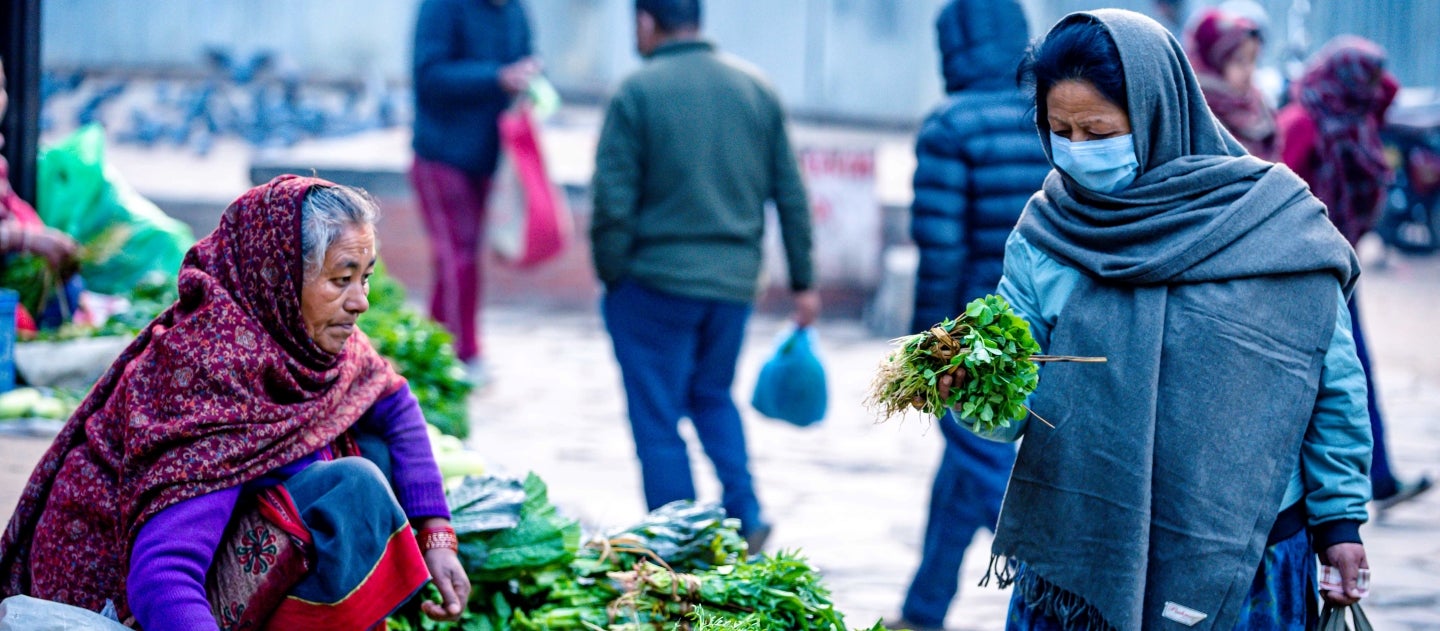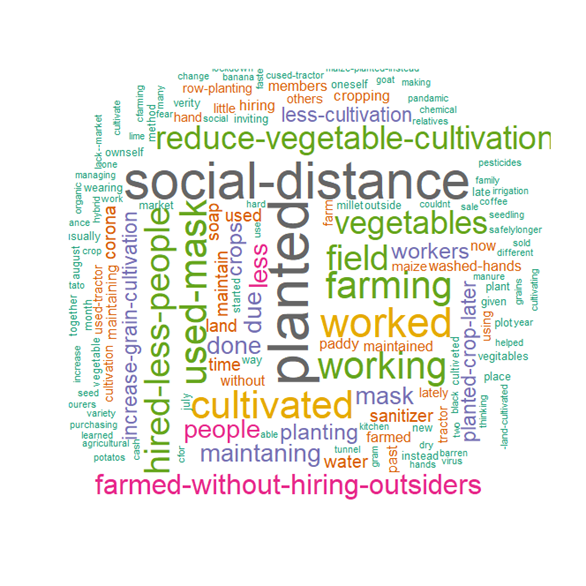 Women selling and buying vegetables in the street of Kathmandu
Women selling and buying vegetables in the street of Kathmandu
“During the last monsoon season, I planted a smaller area than usual because I was not able to get DAP and urea [fertilizers] as I normally would. The lockdowns hindered the availability of such essential supplies,” admits Surya Chepang, a smallholder farmer and among the poorest households in the Benighat Rorang rural municipality in Nepal’s Bagmati Province.
One hundred kilometers away, Sarita Gurung from the Barpak Sulikot rural municipality in Gandaki Province nestled in the Himalayas, shares a similar plight. “We planted less maize than usual because I caught COVID-19 and it is only me and my two children working in the fields, as my husband is working abroad. I have felt lingering physical effects of COVID-19 ever since.”
68% of households that depend on agriculture in Nepal will face severe consequences as a result of COVID-19, making it a critical issue for policy makers
Surya and Sarita are among the thousands of smallholder farmers across Nepal facing the adverse impacts of the COVID-19 pandemic and the subsequent restrictions imposed by the government in early 2021 to curb the spread of the virus. Given that they are subsistence farmers who depend on their crops and livestock to meet their family’s daily nutritional needs—leaving little, if any surplus for sale—a reduction in crop production due to COVID-19 restrictions and lockdowns directly impacts their food security. That means, 68% of households that depend on agriculture in Nepal will face severe consequences as a result of COVID-19, making it a critical issue for policy makers .
Now a new phone survey of 1,186 farming households in Nepal by the World Bank’s Development Impact Evaluation (DIME) team—part of an impact evaluation of the Food and Nutrition Security Enhancement Project (FANSEP)—shows the impact of COVID-19-related disruptions on smallholder farmers’ crop cultivation in the summer of 2021. FANSEP, funded by the Global Agriculture and Food Security Program (GAFSP) trust fund, has been providing smallholder farming communities in the hills and Terai regions of Nepal, knowledge and assets on new cropping techniques to improve agricultural productivity and nutrition practices, and build overall climate resilience.
A new phone survey of 1,186 farming households in Nepal shows the impact of COVID-19-related disruptions on smallholder farmers’ crop cultivation in the summer of 2021
Risks to agriculture and food systems
Here are the highlights from the DIME survey:
Cultivation of the main cereal crop fell
- 5% percent of smallholder farmers reported being unable to plant their main cereal crop—paddy in Terai and maize or millet in the hills—during the summer of 2021 for reasons including lack of family labor, availability of land to cultivate, and the inability to purchase quality seed.
- 47% of large landowners reported that they cultivated less area for the main cereal crop than in the previous year. This number was lower for smallholder farmers at 31%.

Restrictions affected crop planting behavior
- Among the farmers who did cultivate crops, 9% reported making changes to their crop planting behavior due to COVID-19-related restrictions, including social distancing, hand washing, and the usage of masks when planting crops (See Figure 2 below).
- Some farmers reported not planting vegetables due to an inability to sell their crops at the market. They switched back to planting cereals.
- 16% of farmers reported not having sufficient labor to cultivate their land, with most of the affected farmers attributing this to COVID-19 related movement restrictions. Some farmers stopped hiring day laborers from neighboring villages, and preferred to cultivate their plots with family labor or those from their own village to comply with social distancing rules.

Farmers reported job losses
-
20% of the farming households reported job losses, with the smallest quintile of cultivated land area reporting 22% and the farmers with large landholdings reporting 17% respectively.
- 28% of households had a family member who experienced reduced wages in the last four months, and most of those households attributed this to pandemic-related movement restrictions. One in three households reported a reduction in their remittances from household members.
Helping Nepal bet the farm on food security
While the three economic pillars of Nepal—industry, tourism, and agriculture—were all severely affected by COVID-19, the impact on agriculture was felt with a lag—and only now observed by policy makers. The DIME phone survey findings corroborate with the one that the Ministry of Agriculture and Livestock Development conducted had found—that there is an overall 9.5% reduction in aggregate summer paddy production in 2021 and six out of seven provinces in Nepal are reporting less paddy. The policies to limit the spread of COVID-19 combined with the reduction in travel during the pandemic are likely to negatively affect crop cultivation for the already vulnerable population of smallholder farmers , and the situation could exacerbate food insecurity in the coming lean season.
Going forward, it is important to have interventions like FANSEP that provide farmers with products, assets, and training; promote adoption of climate smart technologies; build market linkages; and promote nutrient rich foods. The World Bank is working closely with the FANSEP team to support the government of Nepal’s effort to better target and support the most vulnerable households. Given the global nature of the pandemic, the policy implications and learnings from this program will be relevant to developing countries across the world as they slowly recover from the impacts of COVID-19.
With improved targeting of households like Surya’s and Sarita’s, it is our hope that they restore their crop cultivation and are able to sell their surplus as well as improve their family’s nutrition, moving out of poverty for good.






Join the Conversation